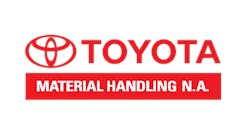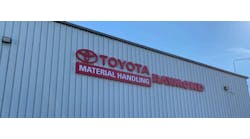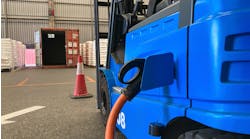Converting from conventional to narrow-aisle storage seems a no-brainer. After all, an operation can store 20% to 25% more product in the same space by taking the narrow-aisle plunge. Even more impressive, switching to a very-narrow-aisle (VNA) system allows for 40% to 50% more product. And, with cost control being the Number One priority these days, we would expect today's storage aisles to be narrower than ever.
But that doesn't seem to be the case. According to David Morzella, warehouse products sales manager at Toyota Material Handling USA Inc. (TMHU), the trend to build up instead of out to limit a building's horizontal footprint and increase cube utilization has paradoxically caused aisles to become slightly wider.
The reason is based on simple physics and safety. “Higher heights require trucks with bigger footprints, so the trucks have become larger, and aisle width must follow,” Morzella explains. “In addition, ergonomics has resulted in bigger operator compartments, resulting in a larger lift truck footprint and, in turn, a larger aisle width.”
Traditionally, the narrow-aisle standard has been nine feet wide, and Morzella says, many material handling professionals still use that benchmark, which can create problems. “They lay out the aisles to be nine-and-a-half-feet wide, but the pallets create three inches of overhang,” he says. “And, that is often overlooked. So, they have to move the pallet rack to get space they need for the truck.”
Morzella says “clear aisle” is the amount of aisle space remaining after pallets are in the racks. “Narrow aisle has been redefined to nine-and-a half to 12-feet wide,” he says. Conventional aisles are 12-feet wide or more. “There's been some crossover between narrow and conventional,” notes Morzella. Because VNA configurations use guided turret trucks and other specialized vehicles, there hasn't been much change in that definition, he adds. Morzella defines VNA systems as less than eight feet.
Further complicating things is the fact that more companies are moving into existing buildings rather than constructing new ones. “They are working within existing parameters in many cases,” Morzella says.
The three main types of lift trucks designed to maneuver in narrow aisles and VNA systems are reach trucks, turret trucks and orderpickers. The Industrial Truck Association categorizes them as Class 2 industrial trucks. Class 2 also includes high-lift straddle trucks; reach-type outriggers; sideloaders, swing mast and convertible turret/stockpickers; and low-lift pallet and platform riders.
Truck Selection
The type of narrow-aisle lift truck to choose depends on how it will be used. Kevin Trenga, product marketing manager for Hyster warehouse trucks, says there are two primary functions of narrow-aisle lift trucks: rack interface and order picking.
“A reach truck is a rack interface truck,” he explains. “It does putaway and letdown of full pallet loads on either side of an aisle as narrow as 96 inches. Orderpickers are operator-up trucks designed for picking cases and units of product and are not for rack interface with pallet loads.”
“Reach trucks are designed to handle lots of putaways and letdowns at high heights plus have the maneuverability to work in the narrow aisle and transport product longer distances,” adds Maria Schwieterman, marketing product manager at Crown Equipment Corp. “Operator-up turret trucks are designed to work within an aisle.”
The ability to make right-angle fork turns makes both reach and turret trucks suitable for pallet-load handling within the racks. Wire- or rail-guided VNA turret trucks can lift operators as well as loads, so they can also be used for order selection. However, neither truck can move loads directly out of trailers and transport them from dock to rack.
Warren Cornil, president of Dallas-based Narrow Aisle Inc., says his company's Flexi truck doesn't have that limitation. The Flexi does not need guiderails, yet it can operate in aisles as narrow as three feet plus the depth of the pallet (usually four feet). “The Flexi will go into a trailer, allowing it to move product from trailer to rack,” Cornil says. “This eliminates the need for a reach truck and allows racking to be placed in the staging area.”
The Bendi lift truck from Marysville, Kan.-based Landoll Corp. also has this ability and is said to be able to maneuver in six-foot-wide aisles. But Cornil says the Flexi is different because it has front-wheel drive, which limits slip and reduces drive-motor maintenance.
Another factor that can influence narrow-aisle truck selection is operating environment. For example, the reach trucks in facilities owned by Phoenix-based Mesa Cold Storage, a 3PL specializing in temperature-controlled warehousing, must operate dependably in Arctic-like conditions.
“Mesa's frozen-grocery operation was demanding because of fluctuations in temperature,” says Pat McCutcheon, branch manager for H&E Equipment Services, the dealer that provided Mesa's lift trucks. Mesa selected Yale NDR035-EA reach trucks because of their reach capabilities — up to 400 inches — and their ability to operate at maximum speed and capacity in demanding conditions.
Recent Advancements
More trucks for narrow-aisle applications are being equipped with AC power, and new models offer greater travel and lift speeds, diagnostic and fleet management technology integrated into the truck as well as traction control, rack-height select and entry bar safety switches, according to Crown's Schwieterman. “As space continues to become a premium for distribution centers, we're seeing an increased need for lift trucks that reach higher while carrying greater capacities than in the past,” she adds.
Hyster's ZR AC-powered reach truck is available in single-reach and double-reach versions. The ZR has four programmable vehicle modes for speed, acceleration, deceleration and hydraulic ramping, according to Hyster, as well as regenerative lowering to minimize battery drain.
Introduced in September 2008, TMHU's 8-Series AC-powered reach truck features a self-adjusting electric disc brake with regenerative braking. The 8-Series also has a torque control system that helps prevent traction loss during acceleration and switch-back operation, according to TMHU.
Crown says its new 5700 reach truck has “the industry's first traction control system.” The OnTrac anti-slip traction control feature uses the integrated Crown Access 1 2 3 control system to analyze grip by comparing the truck's speed with the number of revolutions per minute on the drive tire. The system reduces tire spin during acceleration and prevents wheel lockup during braking. According to Crown, this feature decreases tire wear, increases efficiency, reduces the risk of accidents and improves operator confidence in slick conditions, such as those found in refrigerated or freezer applications. Available with AC-powered drive and hydraulic systems, the 5700 also offers one-touch rack-height select as an add-on feature. Rack-height select allows operators to stop the forks at a specific rack level by clicking a button. It senses when the truck is carrying a load and adjusts rack-entry height accordingly. In addition, a tilt-position-assist function levels the forks during pallet entry at upper rack levels.
Although equipment designs vary by lift truck manufacturer, one constant remains: Today's aisle-width conundrum is more about selecting the right material handling equipment than it is about just saving space.


